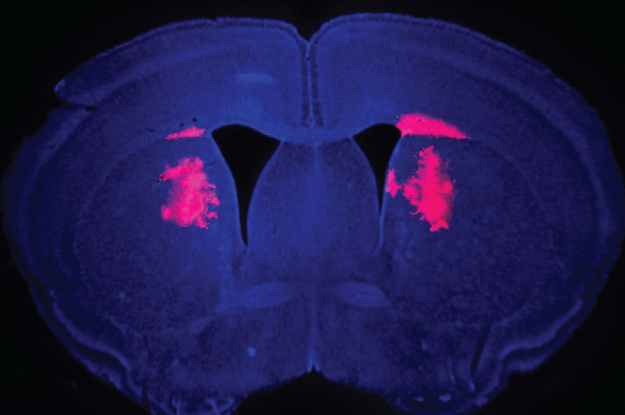Summary: This discovery helps to explain the systematic slowing of movement in patients with Parkinson’s disease and could pave the way for new interventions.
What if you couldn’t move faster even when you wanted to? Researchers thought that the part of the brain that determines how fast we perform voluntary movements, such as walking across a room or playing a melody on the piano, was a bit like a car. It has an accelerator to make movements faster and a brake to slow them down. Now, scientists at the Howard Hughes Medical Institute’s Janelia Research Campus have shown that, contrary to what was thought, the “brake” in this part of the brain can actually accelerate movements in mice, and the gas can rein them in. By determining how the brain controls movement, this discovery helps to explain the systematic slowing of movement in patients with Parkinson’s disease and could pave the way for interventions that allow patients to learn to perform everyday actions more fluidly.
Walking a little faster is no problem for most people, but patients with Parkinson’s disease struggle to accelerate voluntary movements. We have assumed for some time that “it’s almost as if only the brake works and the gas pedal doesn’t work,” says Janelia group leader Joshua Dudman. To better understand this effect, he and his colleague, research scientist Eric Yttri, wanted to find out more about the normal role of the basal ganglia, a brain region that is affected in Parkinson’s disease, in controlling voluntary movement. Within the basal ganglia, there are two main types of neurons known to promote (gas) or suppress (brake) movement.
In experiments described in an advance online publication May 2, 2016 in the journal Nature, Yttri and Dudman used a technique known as optogenetics to activate neurons in the basal ganglia during movements at specific speeds. By shining a laser through fine optical fibers that extend into the animals’ brains, the researchers could selectively stimulate either the gas or the brake neurons to ask how each group influenced future movement.
Yttri trained mice to move a small joystick with their front paws in order to get a sweet drink. The joystick was rigged such that a mouse has to make a choice to satisfy its thirst. The rodent has to push the joystick fast enough to obtain a drink of water, but if it pushes too rapidly it is wasting energy and ultimately limiting the total water it can consume. Every day, people make similar, albeit implicit, decisions about how rapidly they must act – deciding how fast to walk to the neighborhood restaurant on a lunch break. However, in Parkinsonian patients (and as Dudman and colleagues showed previously, Parkinsonian mice) all movements are slowed.
To gauge how forcefully a mouse was pushing, the researchers measured the speed of the joystick. On average, a mouse’s joystick movements take about half a second to complete. Dudman and Yttri first tested the effect of adding extra activity in either group of neurons during specific movements. If the push was predicted to be a swift one based upon its initial speed, the device rapidly activated one or the other group of neurons in the basal ganglia. With this procedure, the researchers could spur the mice to push the joystick systematically faster or slower on future movements, depending on which population of neurons the researchers activated.
Those results are consistent with the long-standing idea that separate populations of neurons in the basal ganglia serve as brake and gas pedal for movement. To determine whether these neurons always had the same effect on movement, the researchers asked what would happen if they activated the neurons when a mouse made a slow movement of the joystick. In this case, switching on the “gas pedal” neurons didn’t accelerate the animals’ movements. Now stimulation systematically slowed future movements. Dudman and Yttri saw a similarly reversed outcome when they triggered the “brake” neurons at the beginning of a slow push. The rodents surprisingly started to move the joystick systematically faster.
Dudman explains, “either one can speed you up or slow you down.” In other words, by showing that releasing the brake can speed movements and releasing the gas pedal can slow movements, the study suggests that we are using a combination of both pathways to regulate movement speed. To visualize how this system adjusts how we move, Dudman says, think of a racecar driver zipping around a track. Instead of either speeding up or slowing down, a driver uses both the gas and brake together to make controlled, but fast turns.
The researchers asked whether this control system could be what is disrupted in Parkinson’s disease. In patients with Parkinson’s, the cells that make a chemical messenger called dopamine die off. To simulate the loss of these cells in the mice, the researchers injected the animals with a compound that blocks dopamine receptors on neurons – mimicking an absence of dopamine. The stimulation that was previously sufficient to change the speed of movement now had no effect.
In addition to clarifying how the basal ganglia controls movements, these results have significant implications for treatment of Parkinson’s disease. Many patients already have implantable devices (deep brain stimulators) that provide electrical stimulation to the brain to improve movement. By selectively activating stimulation during specific movements, similar to what the mice received, such devices might allow patients to access to a normal range of movement speeds.


